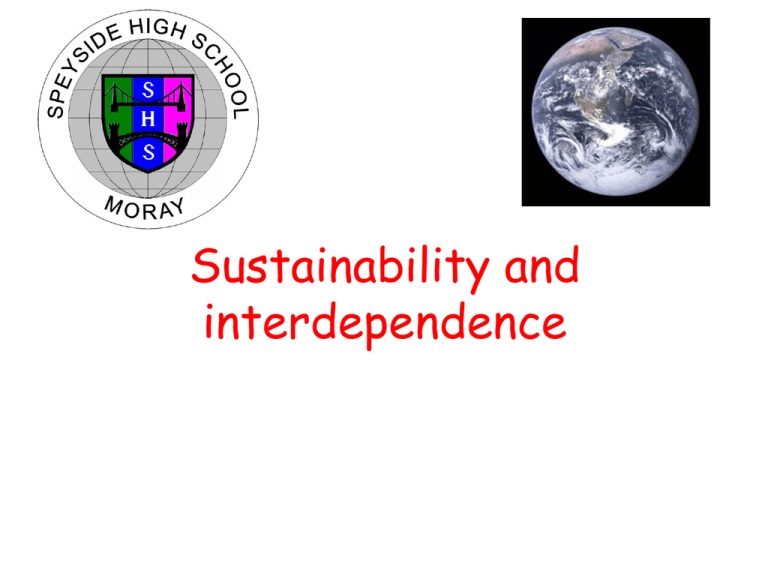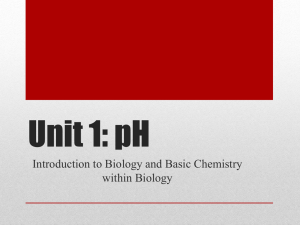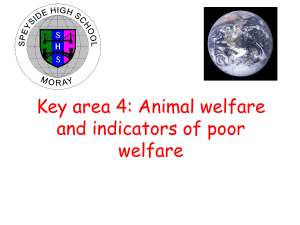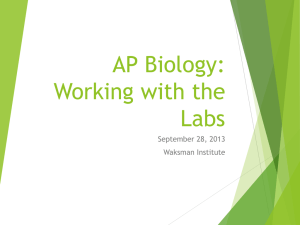Unit 3 Key Area 1 Food supply, plant growth and productivity
advertisement

Sustainability and interdependence Key areas: 1. Food supply, plant growth and productivity 2. Plant and animal breeding by manipulation of heredity 3. Crop protection 4. Animal welfare and behavioural indicators of poor welfare 5. Symbiosis 6. Social behaviour 7. Mass extinction, regaining biodiversity and measuring biodiversity 8. Threats to biodiversity CFE Higher Biology Sustainability and interdependence Key area 1: Food supply, plant growth and productivity Food supply LI: 1. Describe the problems arising from an increasing human population in terms of food supply. 2. Describe how agriculture can be used to control plant growth. CFE Higher Biology Sustainability and interdependence Food supply The human population in currently growing. The present human population is: http://www.census.gov/popclock/ CFE Higher Biology Sustainability and interdependence United Nations estimate of how the human population could increase. CFE Higher Biology Sustainability and interdependence Feeding over 7 billion people requires a sufficient and sustainable supply of food. This makes food security a massively important subject for the future of the human race. CFE Higher Biology Sustainability and interdependence Food security Food security is defined as: Sufficient food must be available at all times Quantity Quality Food security Access CFE Higher Biology Food is sufficiently nutritious and varied to provide a balanced diet People have economic means to Sustainability and obtain the available interdependence food Food security: The challenge Watch these videos Feeding the future and Food security Get a copy of this article from Science (a highly respected science publication) on Food Security. Divide into small groups. Divide the article up and each read a separate section. After reading discuss each section. Come up with a list of the main challenges in assuring food security in the future. How can biological science contribute to solving these challenges? Produce a A4 summary of the challenges and solutions to be photocopied for each group Sustainability member. CFE Higher Biology and interdependence Agricultural production The earth possesses 75,000 edible plant species, yet we depend on a few to produce 95% of what we eat. CFE Higher Biology Sustainability and interdependence Main crop species Cereals Maize Legumes Root crops Rice Potato Cassava Soya bean CFE Higher Biology Sustainability and interdependence Improving yields As the area of land suitable for growing crops is limited, agriculture can: 1. Add minerals (fertiliser) or water (irrigation systems) to remove factors which may be limiting plant growth. CFE Higher Biology Sustainability and interdependence 2. Replace existing strains of crops with a higher-yielding cultivar (cultured variety). 3. Protect crops from pests (e.g. insects), diseases (e.g. fungi), and competition (from weeds) by using pesticides, fungicides and herbicides. 4. Develop pest-resistant crop plants. CFE Higher Biology Sustainability and interdependence Productivity of arable land Think back to National 5: What were the three ways that energy is lost from a food chain? Energy is lost from food chains in the following ways: Undigested food and waste Only 10% is incorporated into body tissues Movement CFE Higher Biology Maintaining body temperature Sustainability and interdependence As you move a long a food chain, energy is lost between each trophic level and the next. 90% energy lost Cereal plant Farm animal 10% energy passed on 90% energy lost Human 10% energy passed on As a result of this loss of energy livestock production generates far less food per area of land than plant production. CFE Higher Biology Sustainability and interdependence Shorter food chains have much less loss of energy: 90% energy lost Cereal plant 10,000 kJ 90% energy lost Farm animal 10% energy passed on 1,000 kJ Human 10% energy passed on 100 kJ 90% energy lost Cereal plant 10,000 kJ Human 10% energy passed on 1,000 kJ CFE Higher Biology Sustainability and interdependence Therefore arable land planted with crops produces far more food than the same land planted with grass to feed livestock. However, not all land can be planted with crops. In this case it is more efficient to use them for livestock. CFE Higher Biology Sustainability and interdependence Plant growth and productivity LI: 1. Describe the processes underlying photosynthesis. 2. Explain the links between photosynthesis and plant productivity. CFE Higher Biology Sustainability and interdependence Plant growth: Photosynthesis Reminder of photosynthesis from National 5: Take a piece of blank paper – discuss the following: • Write the summary word equation for photosynthesis • Name the two stages. • Describe what happens in each stage. Pass the sheet to the next group. Tick the correct bits and add any corrections. CFE Higher Biology Sustainability and interdependence What is light? Light is a form of electromagnetic radiation which travels in waves. Wavelength Light wave The distance between two crests on a wave is called the wavelength and is measured in nanometres (nm). (1 nm = 10-9 m) CFE Higher Biology Sustainability and interdependence Visible light is made up of a spectrum of different colours. Each colour of light has a different wavelength. 400 nm 500 nm 600 nm 700 nm CFE Higher Biology Colour in a copy of the visible light spectrum in your jotters. Sustainability and interdependence The fate of light when it hits a leaf White light hitting a leaf (or any surface) will be either: Reflected Absorbed Transmitted CFE Higher Biology Sustainability and interdependence Light absorption by leaf pigments Leaves contain several coloured pigments of which chlorophyll is the most important. These pigments absorb light energy. These pigments absorb different wavelengths of light. CFE Higher Biology Sustainability and interdependence Which wavelengths of light are used by plants Your teacher will explain how to extract leaf pigments from nettles. Place the leaf pigments solution in front of a spectroscope. This will show which colours are absorbed by the leaf pigments. CFE Higher Biology Sustainability and interdependence • • • • • Collect a leaf and cut into small pieces. Add some propanone and sand into a mortar and pestle. Grind this up, until the propanone turns green. Filter the mixture into a test tube. Hold the spectroscope up towards the test tube and look towards the light. CFE Higher Biology Sustainability and interdependence violet blue green yellow orange red Colour in the normal spectrum. Then colour in a second copy of the spectrum viewed through the leaf pigments: CFE Higher Biology Sustainability and interdependence Spectrum viewed through Chlorophyll violet blue green yellow orange red The blue and violet are no longer visible and only some of the red is still seen. These have been absorbed by the leaf pigments. These are most important wavelengths for a plant in photosynthesis. CFE Higher Biology Sustainability and interdependence Separation of leaf pigments by thin-layer chromatography Follow the instructions for the separation of leaf pigments by chromatography practical. CFE Higher Biology Sustainability and interdependence Absorption and Action Spectra A leaf contains several pigments which can be separated by chromatography. The main pigments are: 1. Chlorophyll a (blue-green*) 2. Chlorophyll b (yellow-green*) 3. Carotene (yellow*) 4. Xanthophyll (yellow*) * This is the colour of the spot on the chromatography paper CFE Higher Biology Sustainability and interdependence An absorption spectrum shows the absorption of light of each wavelength by each pigment. An action spectrum shows the rate of photosynthesis at each light wavelength. Comparison of absorption and action spectra reveals a close match – this is good evidence for the importance of leaf pigments in photosynthesis. Sustainability CFE Higher Biology and interdependence Absorption spectrum Action spectrum CFE Higher Biology Sustainability and interdependence Accessory pigments The xanthophyll and carotene allow the plant to carry out photosynthesis is a wider range of light wavelengths. They are known as accessory pigments as they pass the energy they capture onto chlorophyll a and b. CFE Higher Biology Sustainability and interdependence The chloroplast CFE Higher Biology Sustainability and interdependence The photosynthetic pigments are contained with in the grana. Therefore this is where absorption of light energy and photosynthesis take place. Carbon fixation occurs with in the stroma of the chloroplast. CFE Higher Biology Sustainability and interdependence Capture of energy and photolysis In the chloroplast, when light energy is absorbed by Chlorophyll a, its electrons become excited and are raised to a higher energy state. High energy electrons are captured by the primary energy acceptor. CFE Higher Biology Sustainability and interdependence The electrons are then transferred along an electron transport chain releasing energy. This energy is used by the enzyme ATP synthase to generate ATP. Some of the energy is also used to split water into hydrogen – which is picked by by the hydrogen acceptor NADP to make NADPH – and oxygen. CFE Higher Biology Sustainability and interdependence 1. Light energy is Primary electron + H+ H+ acceptor H absorbed by the chlorophyll creating high-energy electrons Chlorophyll 3. Energy also used to split water Oxygen Water 2. Electron + H+ H+ H passed along transport chain, H+ H+ H+ pumping H+ into grana. 5. Hydrogen ions used by ATP synthase to make ATP for carbon fixation (calvin cycle). H+ ADP + Pi CFE Higher Biology Hydrogen NADP NADPH H+ ATP 4. Hydrogen picked by NADP to make NADPH for carbon fixation (calvin cycle). ATP synthase enzyme Sustainability and interdependence Calvin Cycle (Carbon fixation) At the end of the first stage of photosynthesis (the light dependent stage), the hydrogen (in the form of NADPH) and the ATP are essential for the second stage – known as the Calvin cycle. This takes place in the stroma of the chloroplast. CFE Higher Biology Sustainability and interdependence RuBisCO 3-phosphoglycerate 3-phosphoglycerate Glyceraldehyde-3phosphate CFE Higher Biology Sustainability and interdependence 1. Carbon dioxide enters the cycle and becomes attached to RuBP (ribulose bisphosphate). This reaction is controlled by the enzyme RuBisCO (ribulose bisphosphate carboxylase/oxygenase). 2. The Carbon dioxide and RuBP combine to make 3-phosphoglycerate. CFE Higher Biology Sustainability and interdependence 3. The 3-phosphoglycerate then joins with the hydrogen from NADPH and is phosphorylated by the addition of inorganic phosphate (Pi) from ATP which supplies the energy. 4. This process produces glyceraldehyde-3phosphate (G3P). 5. Some G3P is then used to regenerate RuBP (to continue the process). The remainder is used to synthesis sugars. CFE Higher Biology Sustainability and interdependence Uses of sugar The sugar formed during photosynthesis goes onto the following uses: Glucose Respiration Starch (Storage carbohydrate) Cellulose (Structural carbohydrate e.g. cell wall) CFE Higher Biology Biosynthesis pathways Fats and oils Nucleic acids Proteins Sustainability and interdependence Plant productivity The biomass of a population of plants is its total mass. This is normally measured as dry mass – as the water content of living organisms varies greatly through out the year. CFE Higher Biology Sustainability and interdependence Assimilation The conversion of the glucose produced by photosynthesis into complex components of the plant cell is called assimilation. This process causes an increase in the plants biomass. CFE Higher Biology Sustainability and interdependence Net assimilation As some of the sugar produced in photosynthesis is used up during respiration, therefore: Gain in dry Net assimilation = mass by photosynthesis CFE Higher Biology + Loss in mass caused by respiration Sustainability and interdependence Plant productivity Productivity is the rate at which plants in an ecosystem generate new biomass. It is measured as “units of biomass per unit area per unit time” e.g. grams per square metre per yer. CFE Higher Biology Sustainability and interdependence Factors affecting plant productivity The rate of photosynthesis (and productivity) is affected by several environmental factors known as limiting factors. These include: temperature, light intensity and carbon dioxide concentration. CFE Higher Biology Sustainability and interdependence The rate at which photosynthesis proceeds to limited by which ever one of these factors is in short supply. e.g. Light intensity would be the limiting factor on a dull summer day. CFE Higher Biology Sustainability and interdependence Assessing productivity In order to grow crops efficiently to ensure the maximum yield, farmers/scientists/policy makers need to be able to assess the growing potential of the area. CFE Higher Biology Sustainability and interdependence The biological yield of an area is the total biomass of plant produced this is useful because tells you the total producing power of the land. The economic yield of an area is the mass of the desired product (e.g. mass of just the barley grains from a barley field) CFE Higher Biology Sustainability and interdependence The harvest index is calculated using this formula: dry mass of economic yield dry mass of biological yield This gives a useful estimate of what is wasted during the growth of a crop. CFE Higher Biology Sustainability and interdependence








